Study on the Modification of Confining Rock for Protecting Coal Roadways against Impact Loads from a Roof Stratum
Abstract
:1. Introduction
2. Conception of Modification in the Confining Rock of a Coal Roadway
3. Engineering Background
4. Methodology
4.1. Physical Model Experiment
4.1.1. Similarity Relationship
4.1.2. Physical Model Setup
4.1.3. Impact Loading
4.2. Numerical Model Setup
4.2.1. Software Introduction
4.2.2. Model Characters
4.2.3. Parameters Assignment
4.2.4. Boundary Conditions
4.2.5. Simulated Impact Loads
5. Results and Analysis
5.1. Comparison of the Results of Numerical Model and Physical Model
5.2. Static Stress Redistribution
5.3. Dynamic Response
5.3.1. Dynamic Stress
5.3.2. Damage Evolution
5.3.3. Energy Dissipation
6. Discussion
7. Conclusions
- After the implementation of the confining rock modification of a coal roadway, the stress concentration at the side wall of the roadway will be transferred out of the cracked region and the peak rock pressure will be reduced, thereby eliminating rock burst at the side wall of the coal roadway and protecting the integrality of the confining rock of the coal roadway as well.
- Under the impact load from the roof stratum, the maximum dynamic stress occurred mainly in the intact rock out of the cracked region, and the maximum static–dynamic stress is still distributed out of the cracked region. In addition, the plastic damage in the cracked region under impact load helps absorb the dynamic energy and protect the integrality of the confining rock of a coal roadway.
- The modification of a coal roadway in confining rock decreases the velocity and dynamic energy density significantly at the vault of a coal roadway; therefore, it is capable of reducing the movement of the cracked blocks from the surface of a coal roadway and protecting the staffs or goods in the coal roadway.
Author Contributions
Funding
Data Availability Statement
Acknowledgments
Conflicts of Interest
References
- Keneti, A.; Sainsbury, B.-A. Review of published rockburst events and their contributing factors. Eng. Geol. 2018, 246, 361–373. [Google Scholar] [CrossRef]
- Ma, T.; Tang, C.; Tang, L.; Zhang, W.; Wang, L. Rockburst characteristics and microseismic monitoring of deep-buried tunnels for Jinping II Hydropower Station. Tunn. Undergr. Space Technol. 2015, 49, 345–368. [Google Scholar] [CrossRef]
- Barton, N.; Shen, B. Risk of shear failure and extensional failure around over-stressed excavations in brittle rock. J. Rock Mech. Geotech. Eng. 2017, 9, 210–225. [Google Scholar] [CrossRef]
- Rehman, H.; Naji, A.; Nam, K.; Ahmad, S.; Muhammad, K.; Yoo, H.-K. Impact of Construction Method and Ground Composition on Headrace Tunnel Stability in the Neelum–Jhelum Hydroelectric Project: A Case Study Review from Pakistan. Appl. Sci. 2021, 11, 1655. [Google Scholar] [CrossRef]
- Dou, L.-M.; Mu, Z.-L.; Li, Z.-L.; Cao, A.-Y.; Gong, S.-Y. Research progress of monitoring, forecasting, and prevention of rockburst in underground coal mining in China. Int. J. Coal Sci. Technol. 2014, 1, 278–288. [Google Scholar] [CrossRef] [Green Version]
- Xu, L.; Lu, K.; Pan, Y.; Qin, Z. Study on rock burst characteristics of coal mine roadway in China. Energy Sources Part A Recover. Util. Environ. Eff. 2019, 1–20. [Google Scholar] [CrossRef]
- Kang, H.; Wang, J.; Lin, J. Study and applications of roadway support techniques for coal mines. J. China Coal Soc. 2010, 11, 1809–1814. [Google Scholar]
- Kang, H.; Lin, J.; Fan, M. Investigation on support pattern of a coal mine roadway within soft rocks—A case study. Interna-Tional J. Coal Geol. 2015, 140, 31–40. [Google Scholar] [CrossRef]
- Yu, K.; Ren, F.; Puscasu, R.; Lin, P.; Meng, Q. Optimization of combined support in soft-rock roadway. Tunn. Undergr. Space Technol. 2020, 103, 103502. [Google Scholar] [CrossRef]
- Kabwe, E.; Wang, Y. Review on Rockburst Theory and Types of Rock Support in Rockburst Prone Mines. Open J. Saf. Sci. Technol. 2015, 5, 104–121. [Google Scholar] [CrossRef] [Green Version]
- Simser, B.; Andrieux, P. Field behaviour and failure modes of modified conebolts at the Craig, LaRonde an Brunswick mines in Canada. Aust. Cent. Geomech. 2007, 347–354. [Google Scholar]
- Varden, R.; Lachenicht, R.; Player, J. Development and implementation of the Garford dynamic bolt at the Kanowna Belle Mine. In Proceedings of the 10th Underground Operators Conference, Launceston, Australia, 14–16 April 2008; pp. 14–19. [Google Scholar]
- Charette, F.; Plouffe, M. Roofex®–Results of Laboratory Testing of a New Concept of Yieldable Tendon. Proc. Fourth Int. Semin. Deep. High Stress Min. 2007, 395–404. [Google Scholar] [CrossRef]
- He, M.; Li, C.; Gong, W.; Sousa, L.; Li, S. Dynamic tests for a Constant-Resistance-Large-Deformation bolt using a modified SHTB system. Tunn. Undergr. Space Technol. 2017, 64, 103–116. [Google Scholar] [CrossRef]
- Ma, X.; Pan, Y.S.; Xiao, Y.H. Study on Application of the Mine Anti-Impact and Energy-Absorption Device. Appl. Mech. Mater. 2013, 470, 598–603. [Google Scholar] [CrossRef]
- Wang, J.; Zhang, J. Research on High-Power and High-Speed Hydraulic Impact Testing Machine for Mine Anti-Impact Support Equipment. Shock. Vib. 2019, 2019, 1–12. [Google Scholar] [CrossRef] [Green Version]
- Wang, G.-F.; Li, G.; Dou, L.-M.; Mu, Z.-L.; Gong, S.-Y.; Cai, W. Applicability of energy-absorbing support system for rockburst prevention in underground roadways. Int. J. Rock Mech. Min. Sci. 2020, 132, 104396. [Google Scholar] [CrossRef]
- Gao, M.; He, Y.; Xu, D.; Yu, X. A New Theoretical Model of Rock Burst-Prone Roadway Support and Its Application. Geofluids 2021, 2021. [Google Scholar] [CrossRef]
- Zhao, S.; Ouyang, Z.; Li, X. Theory and Application of Rock Burst Prevention Based on Rigid-flexible Integrated Support with Energy Absorbing. In Proceedings of the 2014 International Conference on Mechanics and Civil Engineering (icmce-14), Wuhan, China, 13–14 December 2014. [Google Scholar]
- Gu, S.; Zhang, W.; Jiang, B.; Hu, C. Case of Rock Burst Danger and Its Prediction and Prevention in Tunneling and Mining Period at an Irregular Coal Face. Geotech. Geol. Eng. 2018, 37, 2545–2564. [Google Scholar] [CrossRef]
- Chen, L.; Li, Q.; Yang, J.; Qiao, L. Laboratory Testing on Energy Absorption of High-Damping Rubber in a New Bolt for Preventing Rockburst in Deep Hard Rock Mass. Shock. Vib. 2018, 2018, 1–12. [Google Scholar] [CrossRef]
- Dou, L.-M.; Lu, C.-P.; Mu, Z.-L.; Gao, M.-S. Prevention and forecasting of rock burst hazards in coal mines. Min. Sci. Technol. 2009, 19, 585–591. [Google Scholar] [CrossRef]
- Yao, B.Z. Influence Analysis of Anchor Parameters on Stability of Surrounding Rock of Roadway with Rock Burst Hazard; Advanced Materials Research; Trans Tech Publications Ltd.: Freienbach, Switzerland, 2012; Volume 368, pp. 1458–1462. [Google Scholar]
- He, M.; Li, C.; Gong, W.; Liu, D.Q. Dynamic behavior of NPR bolt and its application to rock burst control. In Proceedings of the ISRM 2nd Interna-tional Conference on Rock Dynamics, International Society for Rock Mechanics and Rock Engineering, Suzhou, China, 18–19 May 2016. [Google Scholar]
- Tan, X.; Chen, W.; Liu, H.; Chan, A.; Tian, H.; Meng, X.; Wang, F.; Deng, X. A combined supporting system based on foamed concrete and U-shaped steel for underground coal mine roadways undergoing large deformations. Tunn. Undergr. Space Technol. 2017, 68, 196–210. [Google Scholar] [CrossRef]
- Iannacchione, A.T.; Tadolini, S.C. Occurrence, predication, and control of coal burst events in the U.S. Int. J. Min. Sci. Technol. 2016, 26, 39–46. [Google Scholar] [CrossRef]
- Qin, D.; Wang, X.; Zhang, D.; Chen, X. Study on Surrounding Rock-Bearing Structure and Associated Control Mechanism of Deep Soft Rock Roadway Under Dynamic Pressure. Sustainability 2019, 11, 1892. [Google Scholar] [CrossRef] [Green Version]
- Guo, Z.; Wang, J.; Zhang, Y. Failure mechanism and supporting measures for large deformation of Tertiary deep soft rock. Int. J. Min. Sci. Technol. 2015, 25, 121–126. [Google Scholar] [CrossRef]
- Wang, J.-C.; Jiang, F.-X.; Meng, X.-J.; Wang, X.-Y.; Zhu, S.-T.; Feng, Y. Mechanism of Rock Burst Occurrence in Specially Thick Coal Seam with Rock Parting. Rock Mech. Rock Eng. 2016, 49, 1953–1965. [Google Scholar] [CrossRef]
- Jiang, L.; Kong, P.; Zhang, P.; Shu, J.; Wang, Q.; Chen, L.; Wu, Q. Dynamic Analysis of the Rock Burst Potential of a Longwall Panel Intersecting with a Fault. Rock Mech. Rock Eng. 2020, 53, 1737–1754. [Google Scholar] [CrossRef]
- Li, N.; Jimenez, R. A logistic regression classifier for long-term probabilistic prediction of rock burst hazard. Nat. Hazards 2017, 90, 197–215. [Google Scholar] [CrossRef]
- Zhang, Q.; Wang, E.; Feng, X.; Wang, C.; Qiu, L. Assessment of Rockburst Risk in Deep Mining: An Improved Comprehensive Index Method. Nat. Resour. Res. 2021, 30, 1817–1834. [Google Scholar] [CrossRef]
- Kaiser, P.K.; Cai, M. Design of rock support system under rockburst condition. J. Rock Mech. Geotech. Eng. 2012, 4, 215–227. [Google Scholar] [CrossRef] [Green Version]
- Gao, M.; Dou, L.; Zhang, N.; Wang, K.; Zheng, B. Strong-soft-strong mechanical model for controlling roadway surrounding rock subjected to rock burst and its application. Rock Soil Mech. 2008, 29, 359–364. [Google Scholar]
- Li, H.; Lin, B.; Hong, Y.; Gao, Y.; Yang, W.; Liu, T.; Wang, R.; Huang, Z. Effects of in-situ stress on the stability of a roadway excavated through a coal seam. Int. J. Min. Sci. Technol. 2017, 27, 917–927. [Google Scholar] [CrossRef]
- Xie, H.; Gao, M.; Zhang, R.; Peng, G.; Wang, W.; Li, A. Study on the Mechanical Properties and Mechanical Response of Coal Mining at 1000 m or Deeper. Rock Mech. Rock Eng. 2019, 52, 1475–1490. [Google Scholar] [CrossRef]
- Zhang, M.; Jiang, F. Rock burst criteria and control based on an abutment-stress-transfer model in deep coal roadways. Energy Sci. Eng. 2020, 8, 2966–2975. [Google Scholar] [CrossRef]
- Yan, Z.; Dai, F.; Liu, Y.; Du, H. Experimental investigations of the dynamic mechanical properties and fracturing behavior of cracked rocks under dynamic loading. Bull. Int. Assoc. Eng. Geol. 2020, 79, 5535–5552. [Google Scholar] [CrossRef]
- Cho, S.H.; Kaneko, K. Influence of the applied pressure waveform on the dynamic fracture processes in rock. Int. J. Rock Mech. Min. Sci. 2004, 41, 771–784. [Google Scholar] [CrossRef]
- Tang, X. A unified theory for elastic wave propagation through porous media containing cracks—An extension of Biot’s poroelastic wave theory. Sci. China Earth Sci. 2011, 54, 1441–1452. [Google Scholar] [CrossRef]
- Kang, H. Support technologies for deep and complex roadways in underground coal mines: A review. Int. J. Coal Sci. Technol. 2014, 1, 261–277. [Google Scholar] [CrossRef] [Green Version]
- Zhao, M.; Li, H.; Du, X.; Wang, P. Time-Domain Stability of Artificial Boundary Condition Coupled with Finite Element for Dynamic and Wave Problems in Unbounded Media. Int. J. Comput. Methods 2019, 16, 1850099. [Google Scholar] [CrossRef]
- Yi, H.; Qi, T.; Qian, W.; Lei, B.; Pu, B.; Yu, Y.; Liu, Y.; Li, Z. Influence of long-term dynamic load induced by high-speed trains on the accumulative defor-mation of shallow buried tunnel linings. Tunn. Undergr. Space Technol. 2019, 84, 166–176. [Google Scholar] [CrossRef]
- Su, W.; Qiu, Y.-X.; Xu, Y.-J.; Wang, J.-T. A scheme for switching boundary condition types in the integral static-dynamic analysis of soil-structures in Abaqus. Soil Dyn. Earthq. Eng. 2021, 141, 106458. [Google Scholar] [CrossRef]
- Liu, J.; Lu, Y. A direct method for analysis of dynamic soil-structure interaction based on interface idea—ScienceDirect. Dev. Geotech. Eng. 1998, 83, 261–276. [Google Scholar]
- Wang, S.; Gao, B. Damping mechanism and shaking table test on mountain tunnel linings with buffer layers. Chin. J. Rock Mech. Eng. 2016, 35, 592–603. [Google Scholar]
- Ma, S.; Chen, W. Mechanical Properties and Seismic Isolation Mechanism of Foamed Concrete Longitudinal Joints of Tunnel in Rock. In Proceedings of the GeoShanghai International Conference, Shanghai, China, 27–30 May 2018; Springer: Singapore, 2018; pp. 369–375. [Google Scholar]
- Cui, G.; Ma, J. Combination of lining strengthening and buffer layers for soft and hard rock tunnels junction subjected to seismic waves. Geomat. Nat. Hazards Risk 2021, 12, 522–539. [Google Scholar] [CrossRef]

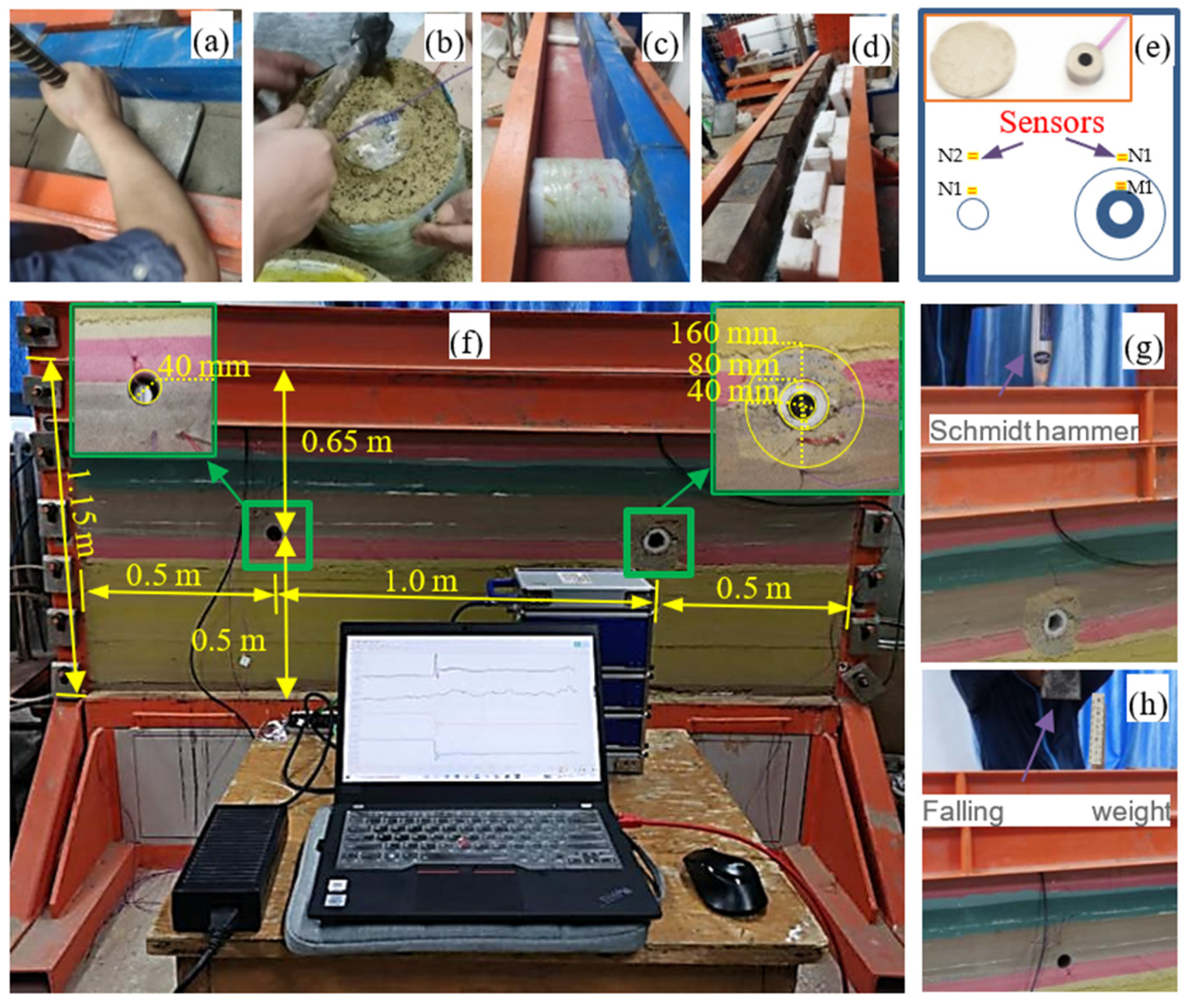

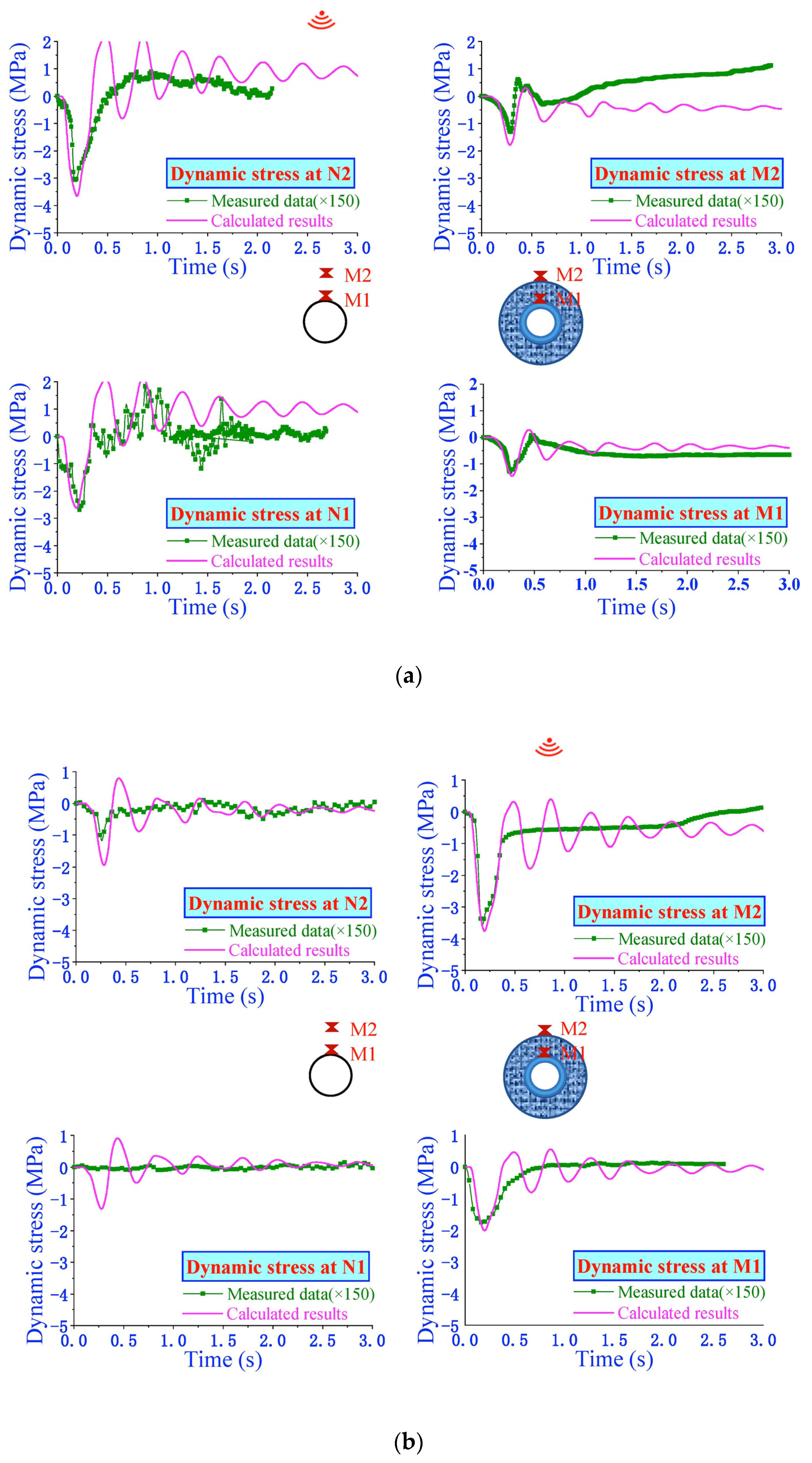
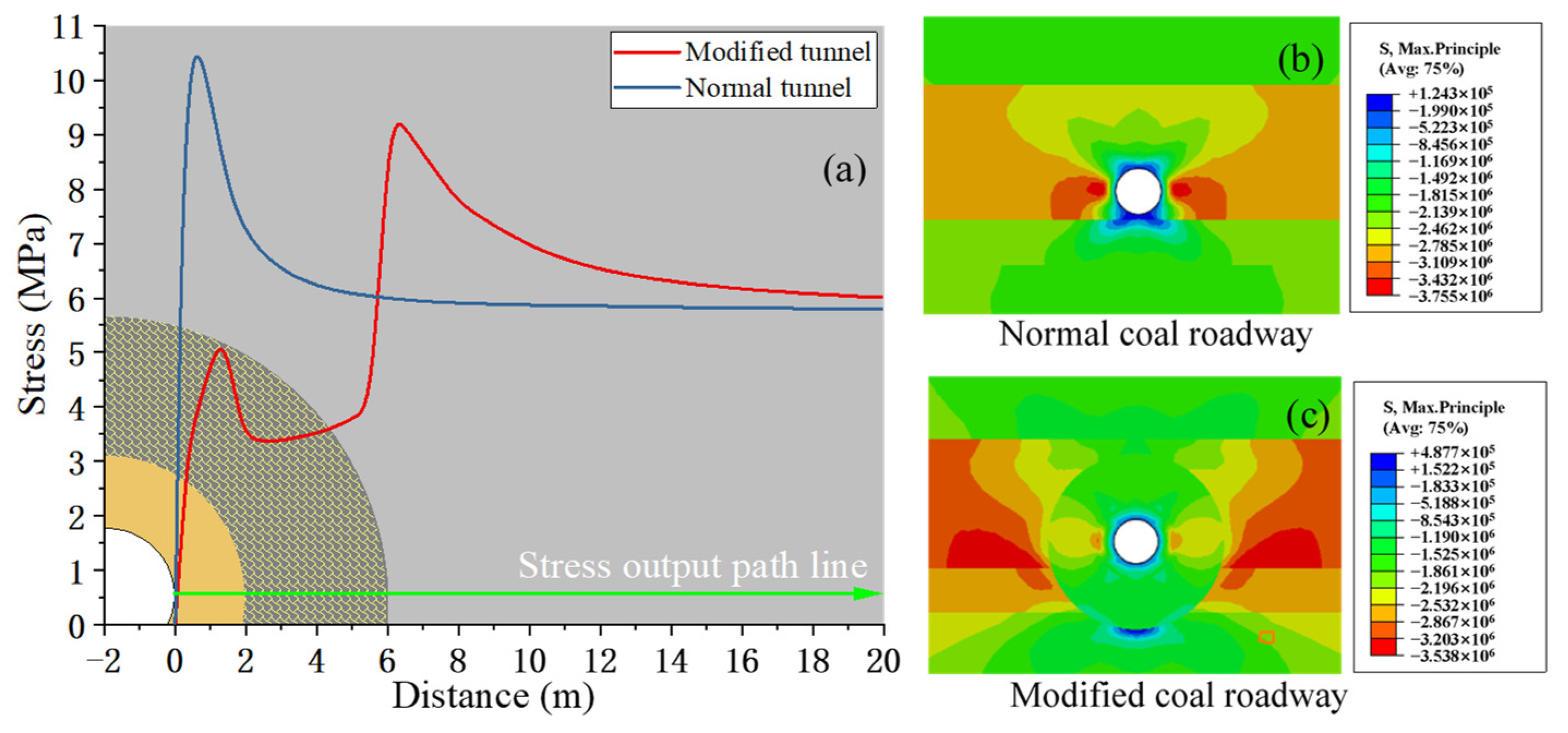
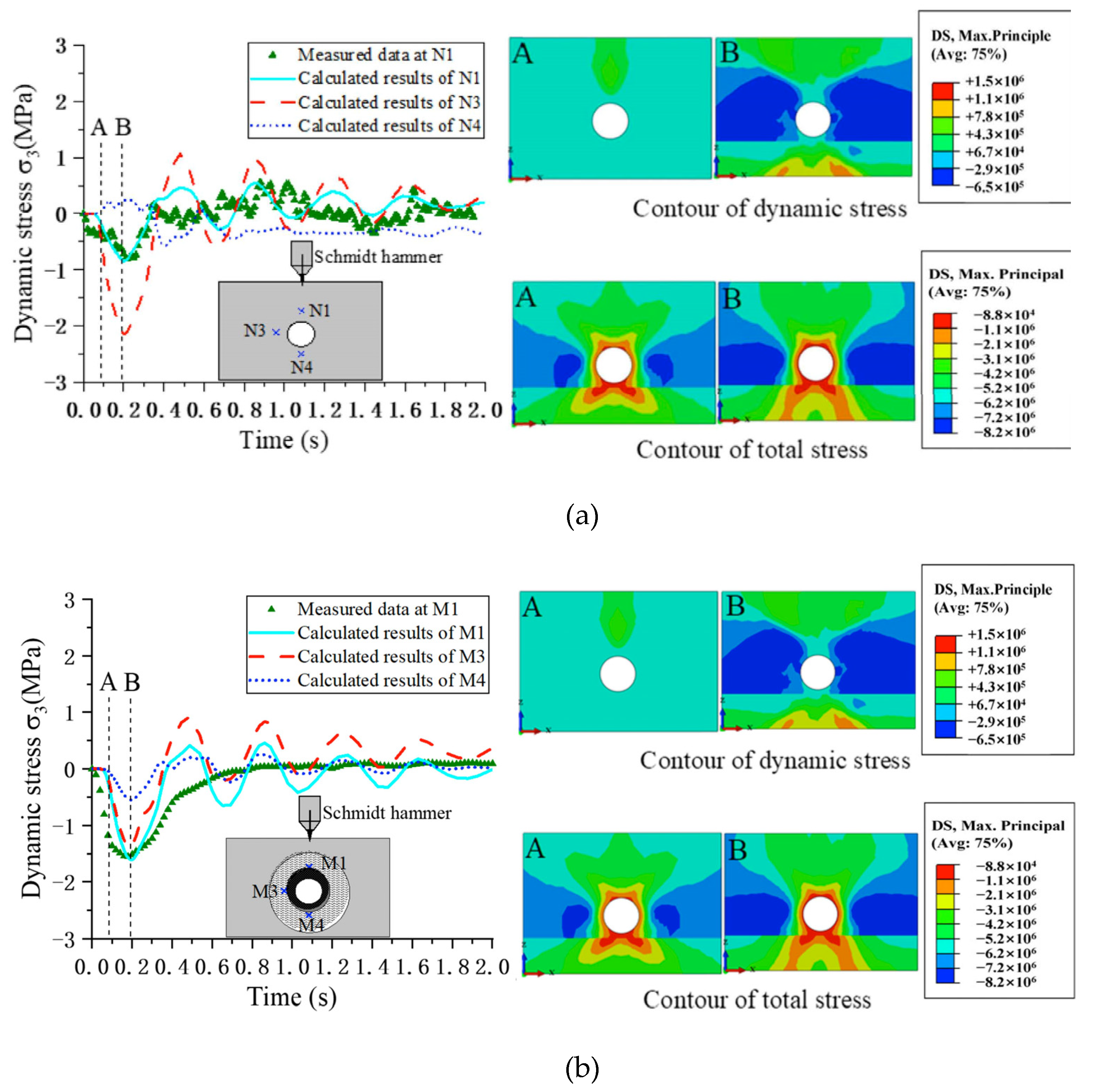


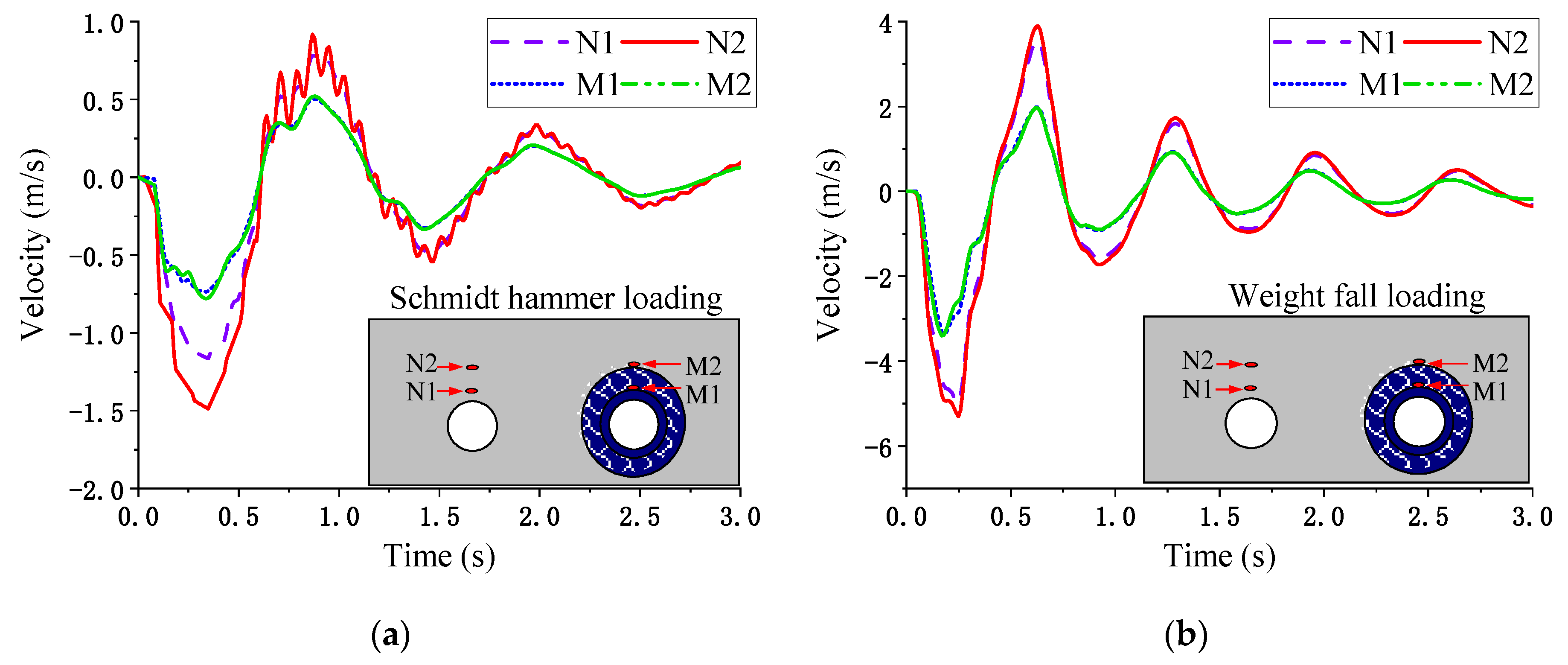

| No. | Hatch Pattern | Lithology | Average Depth/m | Average Thickness/m | Cumulated Distance from B2 Coal Seam/m |
|---|---|---|---|---|---|
| 1 |  | Coarse sandstone | 366.1 | 14.8 | 121.4 |
| 2 |  | Siltstone | 380.9 | 9 | 106.6 |
| 3 |  | Fine sandstone | 389.9 | 26 | 97.6 |
| 4 |  | Sandy mudstone | 415.9 | 6 | 71.6 |
| 5 |  | Coarse sandstone | 421.9 | 7.6 | 65.6 |
| 6 |  | B42 coal seam | 429.5 | 1.5 | 58 |
| 7 |  | Fine sandstone | 431 | 9.6 | 56.5 |
| 8 |  | B41 coal seam | 440.6 | 4 | 46.9 |
| 9 |  | Fine sandstone | 444.6 | 9 | 42.9 |
| 10 |  | Coarse sandstone | 453.6 | 8 | 33.9 |
| 11 |  | B3 coal seam | 461.6 | 1.8 | 25.9 |
| 12 |  | Siltstone | 463.4 | 4.8 | 24.1 |
| 13 |  | Fine sandstone | 468.2 | 19.3 | 19.3 |
| 14 |  | B2 coal seam | 480 | 11.8 | 0 |
| 15 |  | Sandy mudstone | 484 | 4 | −11.8 |
| 16 |  | Fine sandstone | 505 | 21 | −15.8 |
| 17 |  | B1 coal seam | 510.6 | 5.6 | −36.8 |
| 18 |  | Sandy mudstone | 525.6 | 15 | −42.4 |
| 19 |  | Coarse sandstone | 531.5 | 5.9 | −57.4 |
| Quantities | Similitude Relations | Ratios | Quantities | Similitude Relations | Ratios |
|---|---|---|---|---|---|
| Length | Cl = lp/lm | 100 | Strain | Cε = εp/εm = 1 | 1 |
| Density | Cρ = ρp/ρm | 1.5 | Poisson’s ratio | Cv = vp/vm = 1 | 1 |
| Elastic modulus | CE = Ep/Em = CρCgCl | 150 | Velocity | CV = Vp/Vm = CE0.5Cρ−0.5 | 10 |
| Displacement | Cδ = δp/δm = Cl | 100 | Time | CT = Tp/Tm = CLCV−1 | 10 |
| Stress | Cσ = σp/σm = CE | 150 | Acceleration | Cα = αp/αm = Cg | 1 |
| Cohesion | Cc = cp/cm = CE | 150 | Force | CF = Fp/Fm = CρCgCl3 | 1.5 × 106 |
| Friction angle | Cφ = φp/φm = 1 | 1 | Energy | Ce = Fe/Fe = CFCl | 1.5 × 108 |
| Rock Type | Density (kg·m−3) | Young’s Modulus (MPa) | Poisson’s Ratio (-) | Cohesion (MPa) | Friction Angle (o) | Tensile Strength (MPa) |
|---|---|---|---|---|---|---|
| Coarse sandstone | 2530 | 5990 | 0.18 | 6.57 | 39.2 | 5.21 |
| Fine sandstone | 2580 | 4090 | 0.2 | 5.42 | 37 | 4.2 |
| Siltstone | 2570 | 2250 | 0.2 | 4.43 | 37.4 | 3.28 |
| Sandy mudstone | 2510 | 3425 | 0.21 | 3.16 | 36 | 2.75 |
| Coal | 1335 | 1530 | 0.25 | 2.21 | 30.3 | 1.64 |
| Reinforce region | 1335 | 1193 | 0.22 | 2.84 | 34.3 | 2.46 |
| Cracked region | 1600 | 918 | 0.28 | 1.32 | 20 | 0.6 |
| Modeled Rock | Consolidated Thickness (cm) | Weight (g) | |||||
|---|---|---|---|---|---|---|---|
| River Sand | Slacked Lime | Plaster | Water | Kieselguhr | Plastic Particle | ||
| Siltstone | 11 | 51.98 | 0 | 5.78 | 2.89 | 0 | 0 |
| Fine sandstone | 24 | 112 | 4.67 | 14 | 6.3 | 0 | 0 |
| Coal | 12 | 56.7 | 1.09 | 6.3 | 3.15 | 0 | 0 |
| Sandy mudstone | 4 | 18.9 | 2.68 | 2.1 | 1.05 | 0 | 0 |
| Coarse sandstone | 29 | 133.22 | 12.72 | 19 | 7.61 | 0 | 0 |
| Reinforced region | - | 42.5 | 2.64 | 32.6 | 28 | 3 | 0 |
| Cracked region | - | 56.7 | 1.09 | 8.3 | 6.15 | 0 | 14 |
| Velocity (m/s) | N1 | N2 | M1 | M2 |
|---|---|---|---|---|
| Schmidt hammer loading | 1.2 | 1.5 | 0.75 | 0.76 |
| Weight fall loading | 5 | 5.4 | 3.44 | 3.45 |
| Energy Density (KJ/m3) | Normal Roadway | Modified Roadway | ||
|---|---|---|---|---|
| Sandstone | Top Surface | Crack Region | Reinforced Region | |
| Schmidt hammer loading | 4.2 | 3.1 | 2 | 2.3 |
| Weight fall loading | 40 | 28.8 | 17.5 | 20 |
Publisher’s Note: MDPI stays neutral with regard to jurisdictional claims in published maps and institutional affiliations. |
© 2021 by the authors. Licensee MDPI, Basel, Switzerland. This article is an open access article distributed under the terms and conditions of the Creative Commons Attribution (CC BY) license (https://creativecommons.org/licenses/by/4.0/).
Share and Cite
Yi, H.; Ouyang, Z.; Zhou, X.; Li, Z.; Chen, J.; Li, K.; Liu, K. Study on the Modification of Confining Rock for Protecting Coal Roadways against Impact Loads from a Roof Stratum. Minerals 2021, 11, 1331. https://doi.org/10.3390/min11121331
Yi H, Ouyang Z, Zhou X, Li Z, Chen J, Li K, Liu K. Study on the Modification of Confining Rock for Protecting Coal Roadways against Impact Loads from a Roof Stratum. Minerals. 2021; 11(12):1331. https://doi.org/10.3390/min11121331
Chicago/Turabian StyleYi, Haiyang, Zhenhua Ouyang, Xinxin Zhou, Zhengsheng Li, Jianqiang Chen, Kang Li, and Kunlun Liu. 2021. "Study on the Modification of Confining Rock for Protecting Coal Roadways against Impact Loads from a Roof Stratum" Minerals 11, no. 12: 1331. https://doi.org/10.3390/min11121331






